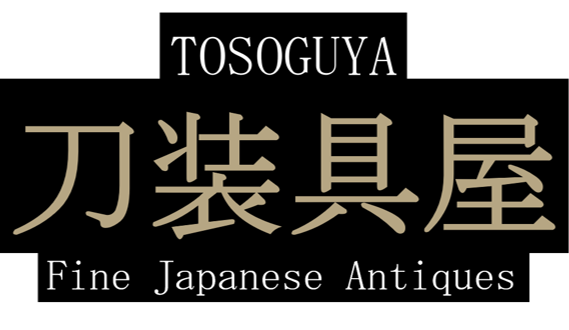

Tachishi Tsuba
Rare ko-kinkō tsuba (古金工鐔) of tachi-style with a traditional wave or nami motif (波図). Usually this type of tsuba is referred to as a Tachishi tsuba (太刀帥鐔). This piece is completely un-altered or ubu (生ぶ). Important to note that while the style of the tsuba is classic tachi style, it was clearly made with original hitsuana, and thus intended for use with uchigatana koshirae. This transitional style was popular from the late 15th to mid 16th century among high ranking samurai, who required uchigatana on the battlefield but wanted to maintain traditional style and high-quality workmanship. The popularity of this genre may be related to the advent and increasing popularity of handachi koshirae (hybrid form between tachi and uchigatana). This tsuba is the highest quality example I have seen of this type.
The tsuba is made of yamagane (山銅) with a greenish-brown patina, making it look like bronze. The tsuba is cast as a single piece of metal, with a huge amount of precise high-relief carving of the original thick billet. Critical to stress how much work went into this tsuba - the plate was down-cut from an original ~9mm thickness to ~1.5mm. This deep carving technique is termed fukabori (深彫), a variant of sukidashi-bori (鋤出彫). Tsuba like this represent the supreme example of the technique. The NBTHK papers use an odd descriptive term for the rim as being an okezoko-mimi (桶底耳), meaning 'bucket-bottom rim' and implying transition to a high wall. This term should generally be confined to early iron ko-katchushi tsuba where the rim is hammered to a high standing profile from the plate. The rim of this tsuba is carved-down, not hammered-high. The rim edge has also been carved with an arabesque motif.
The thin plate has been skillfully engraved with a traditional waves motif, and the ryō-hitsuana (両櫃孔) have been outlined indicating this was always intended for use as an uchigatana tsuba. The four inome sukashi (猪目透) are bordered by inset high-walled collars - same height as the rim. The rim and the inome are all silvered along the top edges (see oblique view). The entire tsuba has been black lacquered, with a great deal of the lacquer surviving on the plate and helping to visually define the engraved motif.
The tsuba has been published in a classic early reference book Tsuba Shūsei. It has been well preserved in Japanese private collections for decades.
Overall, this tsuba is an extremely well-preserved, rare and valuable early soft-metal work which would uplift any collection.
Translation of the NBTHK Hozon paper description follows:
波図鐔 (Nami no zu tsuba)
無銘 古金工 (Mumei Ko-kinkō)
木瓜形 山銅波文地 鋤出彫 (Mokko-gata Yamagane Namimon-ji Sukidashi-bori )
四方猪目小透 桶底耳 両櫃孔 (Shibo-inome Ko-sukashi Okezoko-mimi Ryō-hitsuana)
Heisei 17th year (2005) June 22nd
Published: Tsuba Shūsei (鐔集成), by Nakamura Tessei. 1963.
Measurements: 8.1cm x 7.2cm x 0.9cm
Muromachi Period (室町時代), ~late 15th - early 16th c.
$3,800


